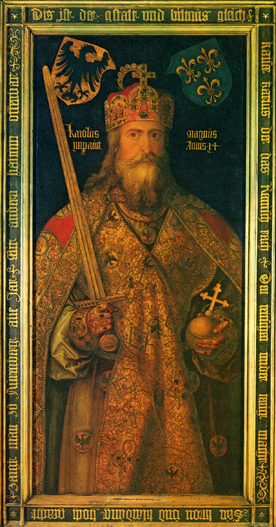
Charlemagne

Kaiser Karl der Große 1512 by Duer
Charlemagne (Latin: Carolus Magnus meaning Charles the Great; possibly 742 - 28th of January 814) was King of the Franks from 768 and Emperor of the Romans (Imperator Romanorum) from 800 to his death in 814. He expanded the Frankish kingdom into an empire that incorporated much of Western and Central Europe. During his reign, he conquered Italy and was crowned Imperator Augustus by Pope Leo III on 25 December 800. This temporarily made him a rival of the Byzantine Emperor in Constantinople. His rule is also associated with the Carolingian Renaissance, a revival of art, religion, and culture through the medium of the Catholic Church. Through his foreign conquests and internal reforms, Charlemagne helped define both Western Europe and the Middle Ages.
The son of King Pepin the Short and Bertrada of Laon, a Frankish queen, he succeeded his father in 768 and co-ruled with his brother Carloman I. The latter got on badly with Charlemagne, but war was prevented by the sudden death of Carloman in 771. Charlemagne continued the policy of his father towards the papacy and became its protector, removing the Lombards from power in Italy, and leading an incursion into Muslim Spain, to which he was invited by the Muslim governor of Barcelona. Charlemagne was promised several Iberian cities in return for giving military aid to the governor; however, the deal was withdrawn. Subsequently, Charlemagne's retreating army experienced its worst defeat at the hands of the Basques, at the Battle of Roncesvalles (778) (memorialized, although heavily fictionalized, in the Song of Roland). He also campaigned against the peoples to his east, especially the Saxons, and after a protracted war subjected them to his rule. By forcibly converting them to Christianity, he integrated them into his realm and thus paved the way for the later Ottonian dynasty of the Holy Roman Empire.

Pepin Annoited King by the Pope
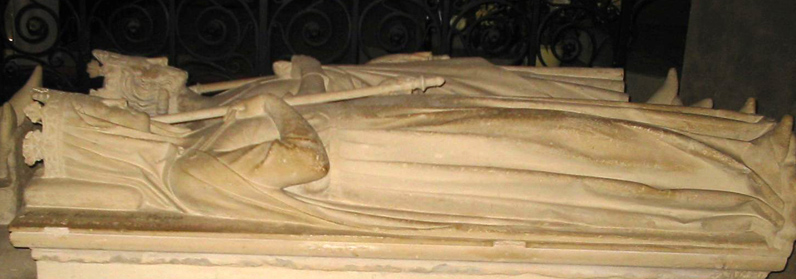
Bertrada of Laon
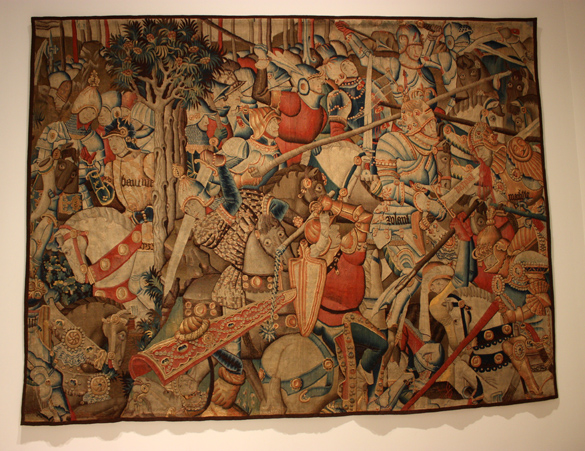
15th Century Tapestry Depicting The Battle of Roncevaux
Medieval Sourcebook: The Song of Roland (O'Hagan Translation)

Eight phases of The Song of Roland in one picture
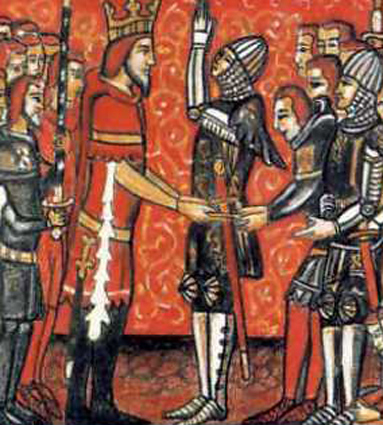
Roland Pledges Fealty
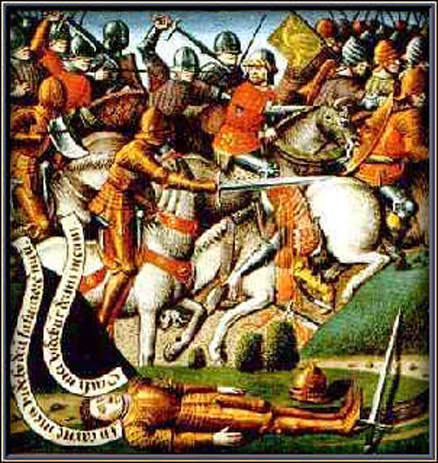
Image of the devastation of the frank troops (from a book of the song of Roland)
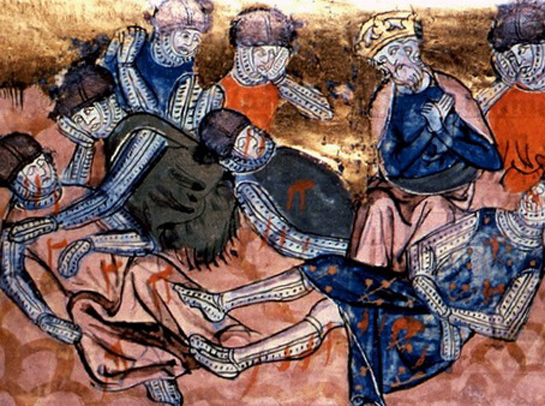
Karlomagno finds Roland dead (XIV. mendeko miniatura)

The Death of Roland at the Battle of Roncevaux,
from an illuminated manuscript c.1455–1460
Today he is regarded not only as the founding father of both French and German monarchies, but also as a Pater Europae (father of Europe): his empire united most of Western Europe for the first time since the Romans, and the Carolingian Renaissance encouraged the formation of a common European identity.
By the 6th century the West Germanic Franks were Christianized and Francia, ruled by the Merovingians, had become the most powerful of the kingdoms which succeeded the Western Roman Empire. But following the Battle of Tertry, the Merovingians declined into a state of powerlessness, for which they have been dubbed the do-nothing kings (rois fainéants). Almost all government powers of any consequence were exercised by their chief officer, the Mayor of the Palace or Maior Domus.
In 687 Pippin of Herstal, Mayor of the Palace of Austrasia, ended the strife between various kings and their Mayors with his victory at Tertry and became the sole governor of the entire Frankish kingdom. Pippin himself was the grandson of two of the most important figures of the Austrasian Kingdom, Saint Arnulf of Metz and Pippin of Landen. Pippin the Middle was eventually succeeded by his illegitimate son Charles, later known as Charles Martel (the Hammer). After 737, Charles governed the Franks without a king on the throne but declined to call himself "king". Charles was succeeded by his sons Carloman and Pepin the Short, the father of Charlemagne. To curb separatism in the periphery of the realm, the brothers placed on the throne Childeric III, who was to be the last Merovingian king.
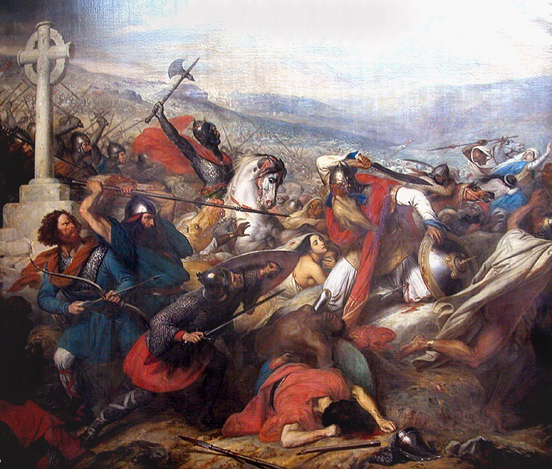
Bataille de Poitiers
Charles Martel is primarily famous for his victory at the Battle of Tours, his stopping the Umayyad invasions of Europe during the Muslim Expansion Era, and his laying the foundation for the Carolingian Empire. (oil on canvas, painted by Charles de Steuben from 1834 to 1837)
After Carloman resigned his office, Pepin, with Pope Zachary's approval, had Childeric III deposed. In 751, Pepin was elected and anointed King of the Franks and in 754 Pope Stephen II again anointed him and his young sons, now heirs to the great realm which already covered most of western and central Europe. Thus was the Merovingian dynasty replaced by the Carolingian dynasty, named after Pepin's father, Charles Martel.
Under the new dynasty, the Frankish kingdom spread to encompass an area including most of Western Europe. The division of that kingdom formed France and Germany; and the religious, political, and artistic evolutions originating from a centrally positioned Francia made a defining imprint on the whole of Western Europe.
Although no description from Charlemagne's lifetime exists, his personal appearance is known from a good description by Einhard, author of the biography Vita Caroli Magni. Einhard tells in his twenty-second chapter:
He was heavily built, sturdy, and of considerable stature, although not exceptionally so, since his height was seven times the length of his own foot. He had a round head, large and lively eyes, a slightly larger nose than usual, white but still attractive hair, a bright and cheerful expression, a short and fat neck, and he enjoyed good health, except for the fevers that affected him in the last few years of his life. Toward the end he dragged one leg. Even then, he stubbornly did what he wanted and refused to listen to doctors, indeed he detested them, because they wanted to persuade him to stop eating roast meat, as was his wont, and to be content with boiled meat.
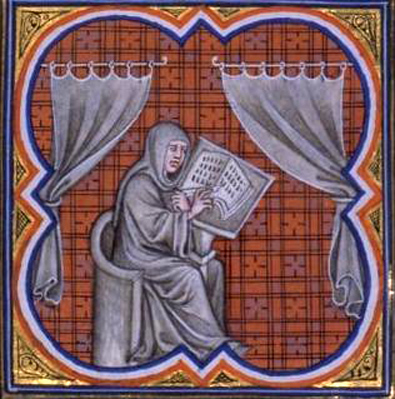
Medieval Sourcebook: Einhard: The Life of Charlemagne (Complete)
The physical portrait provided by Einhard is confirmed by contemporary depictions of the emperor, such as coins and his 8-inch bronze statue kept in the Louvre. In 1861, Charlemagne's tomb was opened by scientists who reconstructed his skeleton and estimated it to be measured 74.9 inches. A modern study based on the dimensions of his tibia estimated his height as 1.84 m. This puts him in the 99th percentile of tall people of his period given that average male height of his time was 1.69 m. (Nota Bene: I am not sure what the conversion of meters to feet would be - mea culpa. S.M.)
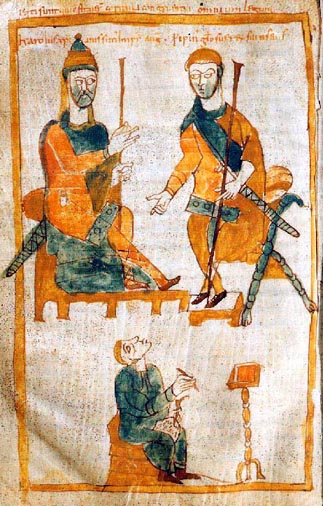
Karl der Grosse and Pippin der Bucklige
Charlemagne (left) and Pippin the Hunchback. Tenth-century
copy of a lost original from about 830
Charles is well known to have been fair-haired, tall, and stately, with a disproportionately thick neck. The Roman tradition of realistic personal portraiture was in complete eclipse in his time, where individual traits were submerged in iconic typecasting. Charlemagne, as an ideal ruler, ought to be portrayed in the corresponding fashion, any contemporary would have assumed. The images of enthroned Charlemagne, God's representative on Earth, bear more connections to the icons of Christ in majesty than to modern (or antique) conceptions of portraiture. Charlemagne in later imagery (as in the Dürer portrait) is often portrayed with flowing blond hair, due to a misunderstanding of Einhard, who describes Charlemagne as having canitie pulchra, or "beautiful white hair", which has been rendered as blonde or fair in many translations.

Charlemagne, Charles the Great (747-814) King of the Franks Emperor of the West by Albrecht Durer on the left.
Emperor Sigismund Holy Roman Emperor King of Hungary and Bohemia circa 1600 by Albrecht Durer on the right.
Charlemagne was the eldest child of Pepin the Short (714 - 768, reigned from 751) and his wife Bertrada of Laon (720 - 783), daughter of Caribert of Laon and Bertrada of Cologne. Records name only Carloman, Gisela, and a short-lived child named Pippin as his younger siblings. The semi-mythical Redburga, wife of King Egbert of Wessex, is sometimes claimed to be his sister (or sister-in-law or niece), and the legendary material makes him Roland's maternal uncle through a lady Bertha.
Much of what is known of Charlemagne's life comes from his biographer, Einhard, who wrote a Vita Caroli Magni, the Life of Charlemagne. Einhard says of the early life of Charles:
It would be folly, I think, to write a word concerning Charles' birth and infancy, or even his boyhood, for nothing has ever been written on the subject, and there is no one alive now who can give information on it. Accordingly, I determined to pass that by as unknown, and to proceed at once to treat of his character, his deeds, and such other facts of his life as are worth telling and setting forth, and shall first give an account of his deeds at home and abroad, then of his character and pursuits, and lastly of his administration and death, omitting nothing worth knowing or necessary to know.
On the death of Pepin, the Kingdom of the Franks was divided - following tradition - between Charlemagne and Carloman. Charles took the outer parts of the kingdom, bordering on the sea, namely Neustria, western Aquitaine, and the northern parts of Austrasia, while Carloman retained the inner parts: southern Austrasia, Septimania, eastern Aquitaine, Burgundy, Provence, and Swabia, lands bordering on Italy.
On October 9th, immediately after the funeral of their father, both the Kings withdrew from Saint Denis to be proclaimed by their nobles and consecrated by the bishops, Charlemagne in Noyon and Carloman in Soissons.
The first event of the brothers' reign was the uprising of the Aquitainians and Gascons, in 769, in that territory split between the two kings. Years before, Pippin had suppressed the revolt of Waifer, Duke of Aquitaine. Now, one Hunold (seemingly other than Hunald the duke) led the Aquitainians as far north as Angoulême. Charlemagne met Carloman, but Carloman refused to participate and returned to Burgundy. Charlemagne went to war, leading an army to Bordeaux, where he set up a fort at Fronsac. Hunold was forced to flee to the court of Duke Lupus II of Gascony. Lupus, fearing Charlemagne, turned Hunold over in exchange for peace. He was put in a monastery. Aquitaine was finally fully subdued by the Franks.
The brothers maintained lukewarm relations with the assistance of their mother Bertrada, but in 770 Charlemagne signed a treaty with Duke Tassilo III of Bavaria and married a Lombard Princess (commonly known today as Desiderata), the daughter of King Desiderius, to surround Carloman with his own allies. Though Pope Stephen III first opposed the marriage with the Lombard princess, he would soon have little to fear from a Frankish-Lombard alliance.
Less than a year after his marriage, Charlemagne repudiated Desiderata, and quickly remarried to a 13-year-old Swabian named Hildegard. The repudiated Desiderata returned to her father's court at Pavia. The Lombard's wrath was now aroused and he would gladly have allied with Carloman to defeat Charles. But before war could break out, Carloman died on 5 December 771. Carloman's wife Gerberga fled to Desiderius' court with her sons for protection.
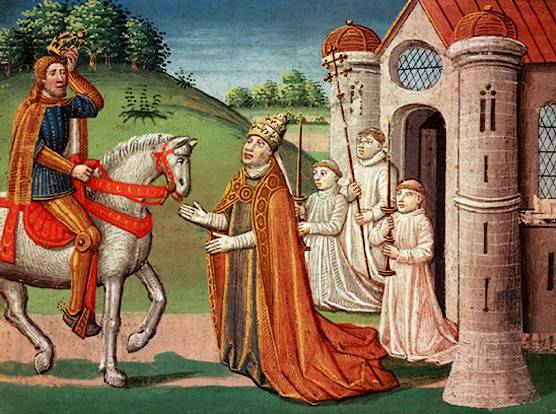
Charlemagne and Pope Adrian I
The Frankish king Charlemagne was a devout Catholic who maintained a close relationship with the papacy throughout his life. In 772, when Pope Adrian I was threatened by invaders, the king rushed to Rome to provide assistance. Shown here, the pope asks Charlemagne for help at a meeting near Rome
Conquest of Lombardy
At the succession of Pope Adrian I in 772, he demanded the return of certain cities in the former exarchate of Ravenna as in accordance with a promise of Desiderius' succession. Desiderius instead took over certain papal cities and invaded the Pentapolis, heading for Rome. Adrian sent embassies to Charlemagne in autumn requesting he enforce the policies of his father, Pippin. Desiderius sent his own embassies denying the pope's charges. The embassies both met at Thionville and Charlemagne upheld the pope's side. Charlemagne promptly demanded what the pope had demanded and Desiderius promptly swore never to comply. Charlemagne and his uncle Bernard crossed the Alps in 773 and chased the Lombards back to Pavia, which they then besieged. Charlemagne temporarily left the siege to deal with Adelchis, son of Desiderius, who was raising an army at Verona. The young prince was chased to the Adriatic littoral and he fled to Constantinople to plead for assistance from Constantine V, who was waging war with Bulgaria.
The siege lasted until the spring of 774, when Charlemagne visited the pope in Rome. There he confirmed his father's grants of land, with some later chronicles claiming - falsely - that he also expanded them, granting Tuscany, Emilia, Venice, and Corsica. The pope granted him the title patrician. He then returned to Pavia, where the Lombards were on the verge of surrendering.
In return for their lives, the Lombards surrendered and opened the gates in early summer. Desiderius was sent to the Abbey of Corbie and his son Adelchis died in Constantinople a Patrician. Charles, unusually, had himself crowned with the Iron Crown and made the magnates of Lombardy do homage to him at Pavia. Only Duke Arechis II of Benevento refused to submit and proclaimed independence. Charlemagne was then master of Italy as king of the Lombards. He left Italy with a garrison in Pavia and a few Frankish counts in place that very year.
There was still instability, however, in Italy. In 776, Dukes Hrodgaud of Friuli and Hildeprand of Spoleto rebelled. Charlemagne rushed back from Saxony and defeated the Duke of Friuli in battle. The Duke was slain. The Duke of Spoleto signed a treaty. Their co-conspirator, Arechis, was not subdued, and Adelchis, their candidate in Byzantium, never left that city. Northern Italy was now faithfully his.
Southern Italy
In 787 Charlemagne directed his attention toward Benevento, where Arechis was reigning independently. Charlemagne besieged Salerno, and Arechis submitted to vassalage. However, with his death in 792, Benevento again proclaimed independence under his son Grimoald III. Grimoald was attacked by armies of Charles or his sons many times, but Charlemagne himself never returned to the Mezzogiorno, and Grimoald never was forced to surrender to Frankish suzerainty.
During the first peace of any substantial length (780-782), Charles began to appoint his sons to positions of authority within the realm, in the tradition of the kings and mayors of the past. In 781 he made his two younger sons kings, having them crowned by the Pope. The elder of these two, Carloman, was made King of Italy, taking the Iron Crown which his father had first worn in 774, and in the same ceremony was renamed "Pippin." The younger of the two, Louis, became King of Aquitaine. Charlemagne ordered Pippin and Louis to be raised in the customs of their kingdoms, and he gave their regents some control of their subkingdoms, but real power was always in his hands, though he intended his sons to inherit their realms some day. Nor did he tolerate insubordination in his sons: in 792, he banished his eldest, though illegitimate, son, Pippin the Hunchback, to the monastery of Prüm, because the young man had joined a rebellion against him.
Charles was determined to have his children educated, including his daughters, as he himself was not. His children were taught all the arts, and his daughters were learned in the way of women. His sons took archery, horsemanship, and other outdoor activities.
The sons fought many wars on behalf of their father when they came of age. Charles was mostly preoccupied with the Bretons, whose border he shared and who insurrected on at least two occasions and were easily put down, but he was also sent against the Saxons on multiple occasions. In 805 and 806, he was sent into the Böhmerwald (modern Bohemia) to deal with the Slavs living there (Czechs). He subjected them to Frankish authority and devastated the valley of the Elbe, forcing a tribute on them. Pippin had to hold the Avar and Beneventan borders but also fought the Slavs to his north. He was uniquely poised to fight the Byzantine Empire when finally that conflict arose after Charlemagne's imperial coronation and a Venetian rebellion. Finally, Louis was in charge of the Spanish March and also went to southern Italy to fight the duke of Benevento on at least one occasion. He took Barcelona in a great siege in the year 797.
Charlemagne's attitude toward his daughters has been the subject of much discussion. He kept them at home with him and refused to allow them to contract sacramental marriages - possibly to prevent the creation of cadet branches of the family to challenge the main line, as had been the case with Tassilo of Bavaria - yet he tolerated their extramarital relationships, even rewarding their common-law husbands, and treasured the illegitimate grandchildren they produced for him. He also, apparently, refused to believe stories of their wild behavior. After his death the surviving daughters were banished from the court by their brother, the pious Louis, to take up residence in the convents they had been bequeathed by their father. At least one of them, Bertha, had a recognized relationship, if not a marriage, with Angilbert, a member of Charlemagne's court circle.
Roncesvalles Campaign
According to the Muslim historian Ibn al-Athir, the Diet of Paderborn had received the representatives of the Muslim rulers of Zaragoza, Girona, Barcelona, and Huesca. Their masters had been cornered in the Iberian peninsula by Abd ar-Rahman I, the Umayyad emir of Córdoba. These Moorish or "Saracen" rulers offered their homage to the Great King of the Franks in return for military support. Seeing an opportunity to extend Christendom and his own power and believing the Saxons to be a fully conquered nation, Charlemagne agreed to go to Spain.
In 778, he led the Neustrian army across the Western Pyrenees, while the Austrasians, Lombards, and Burgundians passed over the Eastern Pyrenees. The armies met at Zaragoza and Charlemagne received the homage of the Muslim rulers, Sulayman al-Arabi and Kasmin ibn Yusuf, but the city did not fall for him. Indeed, Charlemagne was facing the toughest battle of his career where the Muslims had the upper hand and forced him to retreat. He decided to go home, since he could not trust the Basques, whom he had subdued by conquering Pamplona. He turned to leave Iberia, but as he was passing through the Pass of Roncesvalles one of the most famous events of his long reign occurred. The Basques fell on his rearguard and baggage train, utterly destroying it. The Battle of Roncevaux Pass, less a battle than a mere skirmish, left many famous dead: among which were the seneschal Eggihard, the count of the palace Anselm, and the warden of the Breton March, Roland, inspiring the subsequent creation of the Song of Roland (La Chanson de Roland).
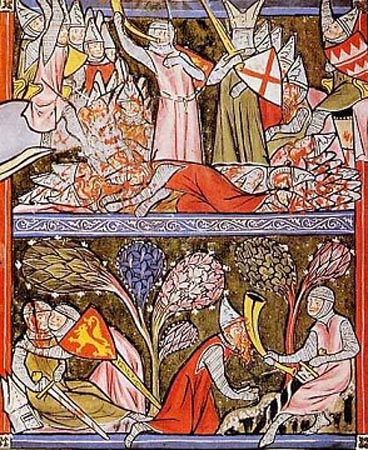
Roncevaux Pass
Wars with the Moors
The conquest of Italy brought Charlemagne in contact with the Saracens who, at the time, controlled the Mediterranean. Pippin, his son, was much occupied with Saracens in Italy. Charlemagne conquered Corsica and Sardinia at an unknown date and in 799 the Balearic Islands. The islands were often attacked by Saracen pirates, but the counts of Genoa and Tuscany (Boniface) kept them at bay with large fleets until the end of Charlemagne's reign. Charlemagne even had contact with the Caliph's court in Baghdad. In 797 (or possibly 801), the Caliph of Baghdad, Harun al-Rashid, presented Charlemagne with an Asian elephant named Abul-Abbas and a clock.
In Hispania the struggle against the Moors continued unabated throughout the latter half of his reign. His son Louis was in charge of the Spanish border. In 785, his men captured Gerona permanently and extended Frankish control into the Catalan littoral for the duration of Charlemagne's reign (and much longer, it remained nominally Frankish until the Treaty of Corbeil in 1258). The Muslim chiefs in the northeast of Islamic Spain were constantly revolting against Córdoban authority, and they often turned to the Franks for help. The Frankish border was slowly extended until 795, when Gerona, Cardona, Ausona, and Urgel were united into the new Spanish March, within the old duchy of Septimania.
In 797 Barcelona, the greatest city of the region, fell to the Franks when Zeid, its governor, rebelled against Córdoba and, failing, handed it to them. The Umayyad authority recaptured it in 799. However, Louis of Aquitaine marched the entire army of his kingdom over the Pyrenees and besieged it for two years, wintering there from 800 to 801, when it capitulated. The Franks continued to press forward against the emir. They took Tarragona in 809 and Tortosa in 811. The last conquest brought them to the mouth of the Ebro and gave them raiding access to Valencia, prompting the Emir al-Hakam I to recognize their conquests in 812.
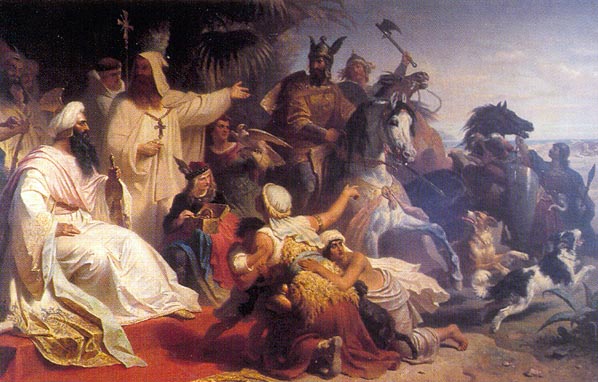
Harun-al Rashid Receives Charlemagne
Harun al-Rashid receiving a delegation of Charlemagne in Baghdad, by Julius Köcker

Frankish Empire: 481 to 814
Saxon Wars
Charlemagne was engaged in almost constant battle throughout his reign, often at the head of his elite scara bodyguard squadrons, with his legendary sword Joyeuse in hand. After thirty years of war and eighteen battles - the Saxon Wars - he conquered Saxonia and proceeded to convert the conquered to Christianity.
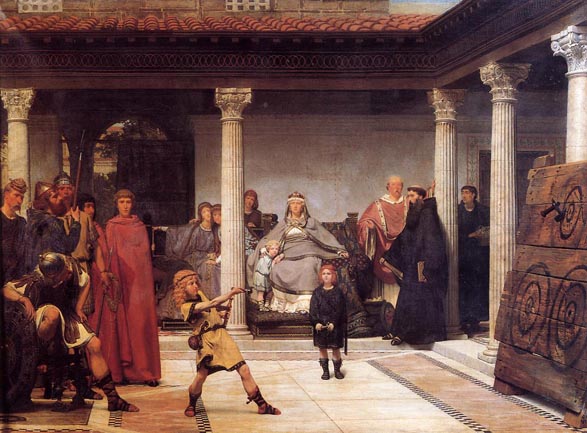
The Education of the Children of Clovis
by Sir Lawrence Alma-Tadema
Clovis I (465-511), king of the Franks. In 481 he succeeded his father, Childeric I, as king of the Salian Franks.
In 486 he overthrew the last Roman governor in Gaul and took control of the whole country. In 493 he married
St. Clotilda of Burgundy, through whom he was converted to Christianity in 496. Thanks to continuous conquests
of the neighbouring lands he enlarged his kingdom and made his capital in Paris. After his death the Frankish
Kingdom was divided among his four sons.
The Germanic Saxons were divided into four subgroups in four regions. Nearest to Austrasia was Westphalia and furthest away was Eastphalia. In between these two kingdoms was that of Engria and north of these three, at the base of the Jutland peninsula, was Nordalbingia.
In his first campaign, Charlemagne forced the Engrians in 773 to submit and cut down an Irminsul pillar near Paderborn. The campaign was cut short by his first expedition to Italy. He returned in 775, marching through Westphalia and conquered the Saxon fort of Sigiburg. He then crossed Engria, where he defeated the Saxons again. Finally, in Eastphalia, he defeated a Saxon force, and its leader Hessi converted to Christianity. He returned through Westphalia, leaving encampments at Sigiburg and Eresburg, which had, up until then, been important Saxon bastions. All of Saxony but Nordalbingia was under his control, but Saxon resistance had not ended.
Following his campaign in Italy subjugating the Dukes of Friuli and Spoleto, Charlemagne returned very rapidly to Saxony in 776, where a rebellion had destroyed his fortress at Eresburg. The Saxons were once again brought to heel, but their main leader, Widukind, managed to escape to Denmark, home of his wife. Charlemagne built a new camp at Karlstadt. In 777, he called a national diet at Paderborn to integrate Saxony fully into the Frankish kingdom. Many Saxons were baptized as Christians.
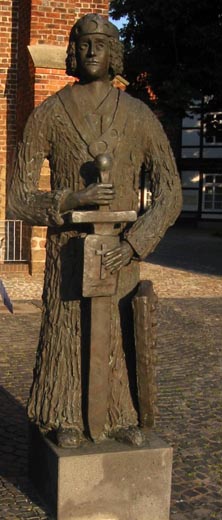
Widukind
In the summer of 779, he again invaded Saxony and re-conquered Eastphalia, Engria, and Westphalia. At a diet near Lippe, he divided the land into missionary districts and himself assisted in several mass baptisms (780). He then returned to Italy and, for the first time, there was no immediate Saxon revolt. Saxony was peaceful from 780 to 782.
He returned to Saxony in 782 and instituted a code of law and appointed counts, both Saxon and Frank. The laws were draconian on religious issues; for example, the Capitulatio de partibus Saxoniae prescribed death to Saxon pagans who refused to convert to Christianity. This revived a renewal of the old conflict. That year, in autumn, Widukind returned and led a new revolt. In response, at Verden in Lower Saxony, Charlemagne is recorded as having ordered the execution of 4,500 Saxon prisoners, known as the Massacre of Verden ("Verdener Blutgericht"). The killings triggered three years of renewed bloody warfare (783-785). During this war the Frisians were also finally subdued and a large part of their fleet was burned. The war ended with Widukind accepting baptism.
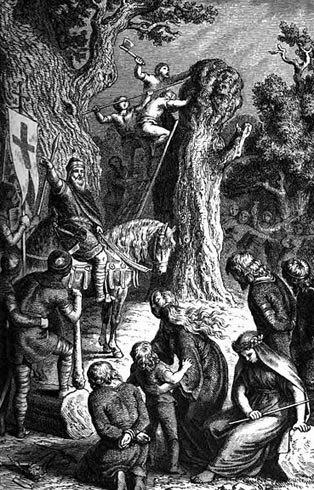
The Massacre at Verden
by Albert Camus
In Verden
They fell;
One by one
Saxons all
Five hundred plus four thousand
Beneath the old council tree
Each tribal chieftan's head did fall.
Long lines of men
Beneath alder trees tall.
A breeze moved their beards,
But they could not see.
It was overcast
The sun was blind
The sky did not witness,
But flowing them beside,
Through reeds, the river Aller spoke:
Sons of ancient pride,
Why stand you in silence
Long lines, somber eyed?
One giant with braided mane
Hands lashed to point of pain
He heard the river and he spoke:
Mother of Saxons and Germans old,
From Charlemagne the new king
Of Christ a new god we were told;
Now his praises we must sing
Renounce our tribal faith and blood
'Else drown beneath the Frankish flood.
Charlemagne says:
Pagan Chiefs! Kneel to Christ and kiss his feet.
Saxon, lower your eyes and incline your brow-
Or by the holy cross, our swords will be fleet
Axes shall fall on they who do not bow.
The river Aller sighed:
Saxon, ancient son, I know.
My waters with blood do flow.
A river of death have I become.
So the line progressed,
And they fell
One by one
With bound hands
Under bloody axe
Saxons all
Five hundred plus four thousand
Beneath the old council tree
Each chieftan's head did fall.
The river ran bloody
Red stain upon the land
Charlemagne killed the chiefs
Converting their tribes to Christ,
Under the old Saxon council tree
The stack of heads and bodies did grow
While blood into the river Aller flowed.
Inhumanitas omni aetate molesta est
~ Inhumanity is harmful in every age.
~ Cicero
Intolerance and especially religious intolerance had no place in society yesterday and the emergence of such attitudes today is a sad indictment of ourselves when we claim to live in a free civilized society.
Senex Magister
Thereafter, the Saxons maintained the peace for seven years, but in 792 the Westphalians again rose against their conquerors. The Eastphalians and Nordalbingians joined them in 793, but the insurrection did not catch on and was put down by 794. An Engrian rebellion followed in 796, but the presence of Charlemagne, Christian Saxons and Slavs quickly crushed it. The last insurrection of the independent-minded people occurred in 804, more than thirty years after Charlemagne's first campaign against them. This time, the most restive of them, the Nordalbingians, found themselves effectively disempowered from rebellion for the time being. According to Einhard:
The war that had lasted so many years was at length ended by their acceding to the terms offered by the King; which were renunciation of their national religious customs and the worship of devils, acceptance of the sacraments of the Christian faith and religion, and union with the Franks to form one people.
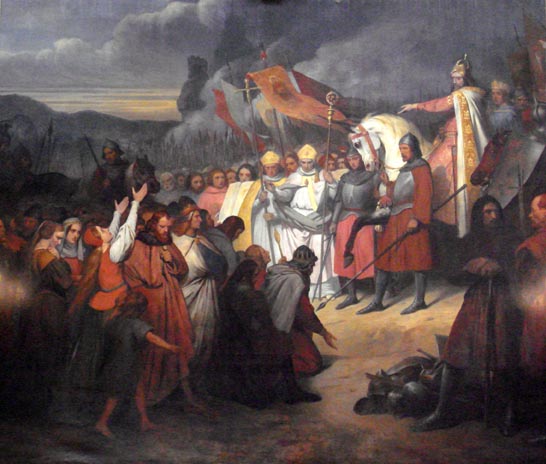
Charlemagne (742-814) receiving the submission of Witikind at Paderborn in 785
by Ary Schefferr (1795-1858)
Submission of Bavaria
In 788, Charlemagne turned his attention to Bavaria. He claimed Tassilo was an unfit ruler, on account of his oath-breaking. The charges were trumped up, but Tassilo was deposed anyway and put in the monastery of Jumièges. In 794, he was made to renounce any claim to Bavaria for himself and his family (the Agilolfings) at the synod of Frankfurt. Bavaria was subdivided into Frankish counties, as had been done with Saxony.
Avars Campaigns
In 788, the Avars, a pagan Asian horde which had settled down in what is today Hungary (Einhard called them Huns), invaded Friuli and Bavaria. Charlemagne was preoccupied until 790 with other things, but in that year, he marched down the Danube into their territory and ravaged it to the Raab. Then, a Lombard army under Pippin marched into the Drava valley and ravaged Pannonia. The campaigns would have continued if the Saxons had not revolted again in 792, breaking seven years of peace.
For the next two years, Charlemagne was occupied with the Slavs against the Saxons. Pippin and Duke Eric of Friuli continued, however, to assault the Avars' ring-shaped strongholds. The great Ring of the Avars, their capital fortress, was taken twice. The booty was sent to Charlemagne at his capital, Aachen, and redistributed to all his followers and even to foreign rulers, including King Offa of Mercia. Soon the Avar tuduns had thrown in the towel and travelled to Aachen to subject themselves to Charlemagne as vassals and Christians. This Charlemagne accepted and sent one native chief, baptized Abraham, back to Avaria with the ancient title of khagan. Abraham kept his people in line, but in 800 the Bulgarians under Khan Krum swept the Avar state away. In the 10th century, the Magyars settled the Pannonian plain and presented a new threat to Charlemagne's descendants.
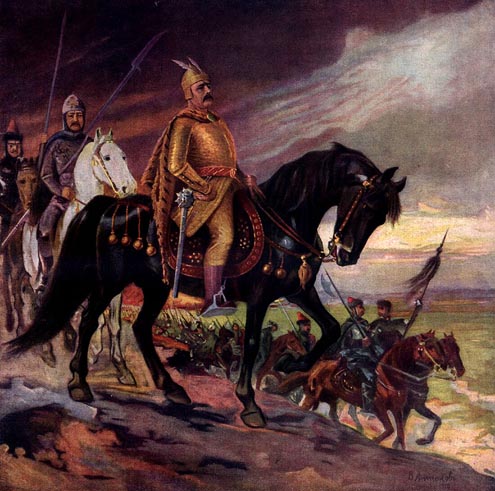
Khan Krum of Bulgaria
by V. Antonoff
Northeast Slav Expeditions
In 789, in recognition of his new pagan neighbors, the Slavs, Charlemagne marched an Austrasian-Saxon army across the Elbe into Obotrite territory. The Slavs immediately submitted under their leader Witzin. Charlemagne then accepted the surrender of the Wiltzes under Dragovit and demanded many hostages and the permission to send, unmolested, missionaries into the pagan region. The army marched to the Baltic before turning around and marching to the Rhine with much booty and no harassment. The tributary Slavs became loyal allies. In 795, when the Saxons broke the peace, the Abotrites and Wiltzes rose in arms with their new master against the Saxons. Witzin died in battle and Charlemagne avenged him by harrying the Eastphalians on the Elbe. Thrasuco, his successor, led his men to conquest over the Nordalbingians and handed their leaders over to Charlemagne, who greatly honored him. The Abotrites remained loyal until Charles' death and fought later against the Danes.
Southeast Slav Expeditions
When Charlemagne incorporated much of Central Europe, he brought the Frankish state face to face with the Avars and Slavs in the southeast. The most southeast Frankish neighbors were Croats, who settled in Pannonian Croatia and Littoral Croatian Duchy. While fighting the Avars, the Franks had called for their support. During the 790's, when Charlemagne campaigned against the Avars, he won a major victory in 796. Pannonian Croatian Duke Vojnomir of Pannonian Croatia aided Charlemagne, and the Franks made themselves overlords over the Croatians of northern Dalmatia, Slavonia, and Pannonia.

The Coming of the Croats to the Adriatic
by Oton Ivekovic
The Frankish Commander Eric of Friuli wanted to extend his dominion by conquering Littoral Croatian Duchy. During that time, Littoral Croatia was ruled by Duke Višeslav of Croatia, who was one of the first known Croatian dukes. In the Battle of Trsat, the forces of Eric fled their positions and were totally routed by the forces of Višeslav. Eric himself was among the killed, and his death and defeat proved a great blow for the Carolingian Empire.
Charlemagne also directed his attention to the Slavs to the west of the Avar khaganate: the Carantanians and Carniolans. These people were subdued by the Lombards and Bavarii, were made tributaries, but were never fully incorporated into the Frankish state.
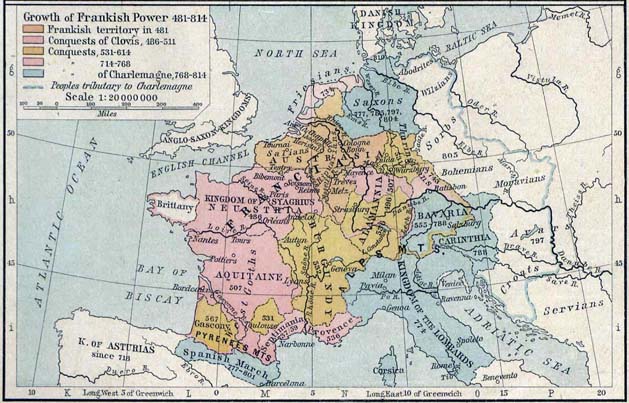
Growth of Frankish Power, 481-814
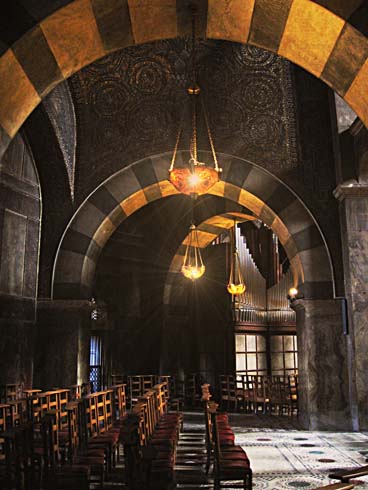
Aachen Cathedral - Interior
Imperial Diplomacy
In 799, Pope Leo III had been mistreated by the Romans, who tried to put out his eyes and tear out his tongue. Leo escaped and fled to Charlemagne at Paderborn, asking him to intervene in Rome and restore him. Charlemagne, advised by Alcuin of York, agreed to travel to Rome, doing so in November 800 and holding a council on December 1. On December 23rd Leo swore an oath of innocence. At Mass, on Christmas Day (December 25th), when Charlemagne knelt at the altar to pray, the Pope crowned him Imperator Romanorum ("Emperor of the Romans") in Saint Peter's Basilica. In so doing, the Pope was effectively attempting to transfer the office from Constantinople to Charles. Einhard says that Charlemagne was ignorant of the Pope's intent and did not want any such coronation:
He at first had such an aversion that he declared that he would not have set foot in the Church
the day that they (the imperial titles) were conferred, although it was a great feast-day,
if he could have foreseen the design of the Pope.
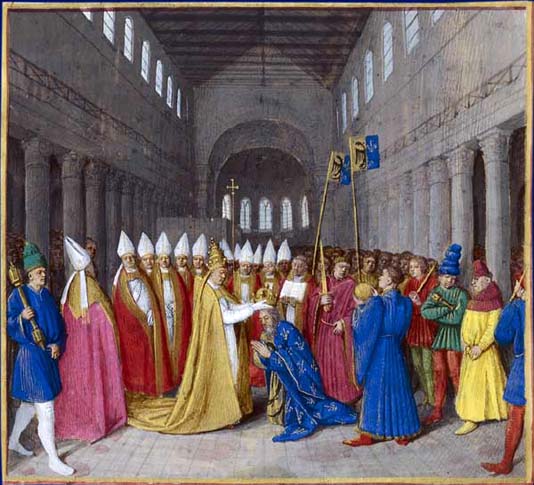
Sacre de Charlemagne
Many modern scholars suggest that Charlemagne was indeed aware of the coronation; certainly he cannot have missed the bejeweled crown waiting on the altar when he came to pray. In any event, he used these circumstances to claim that he was the restorer of the Roman Empire, which had apparently fallen into degradation under the Byzantines. In his official charters, Charles preferred the style Karolus Serenissimus Augustus a Deo coronatus magnus pacificus imperator Romanum gubernans imperium ("Charles, most serene Augustus crowned by God, the great, peaceful emperor ruling the Roman empire") to a more direct Imperator Romanorum ("Emperor of the Romans").
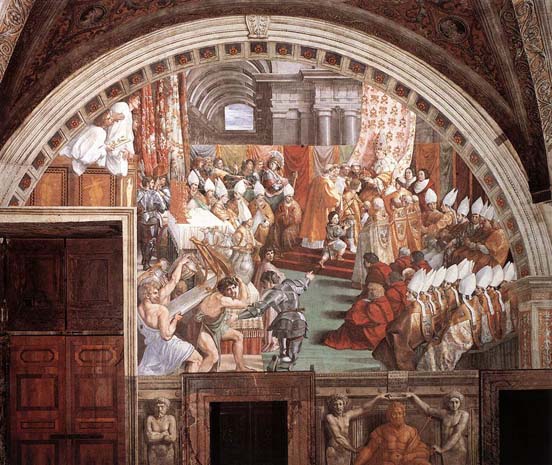
The Coronation of Charlemagne
by Assistants of Raphael
The Iconoclasm of the Isaurian Dynasty and resulting religious conflicts with the Empress Irene, sitting on the throne in Constantinople in 800, were probably the chief causes of the Pope's desire to formally acclaim Charles as Roman Emperor. He also most certainly desired to increase the influence of the papacy, honor his savior Charlemagne, and solve the constitutional issues then most troubling to European jurists in an era when Rome was not in the hands of an emperor. Thus, Charlemagne's assumption of the imperial title was not an usurpation in the eyes of the Franks or Italians. It was, however, in Byzantium, where it was protested by Irene and her successor Nicephorus I - neither of whom had any great effect in enforcing their protests.
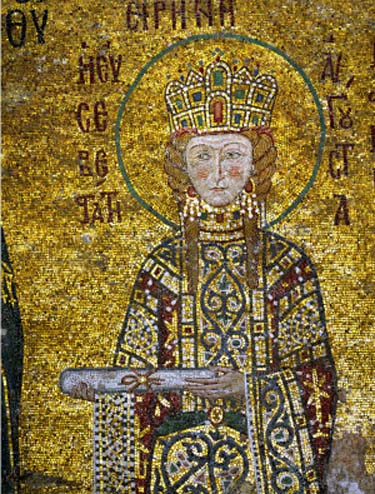
Empress Irene
The Byzantines, however, still held several territories in Italy: Venice (what was left of the Exarchate of Ravenna), Reggio (in Calabria), Brindisi (in Apulia), and Naples (the Ducatus Neapolitanus). These regions remained outside of Frankish hands until 804, when the Venetians, torn by infighting, transferred their allegiance to the Iron Crown of Pippin, Charles' son. The Pax Nicephori ended. Nicephorus ravaged the coasts with a fleet, and the only instance of war between the Byzantines and the Franks, as it was, began. It lasted until 810, when the pro - Byzantine party in Venice gave their city back to the Byzantine Emperor, and the two emperors of Europe made peace: Charlemagne received the Istrian peninsula and in 812 the emperor Michael I Rhangabes recognized his status as Emperor, although not necessarily as "Emperor of the Romans".
Danish Attacks
After the conquest of Nordalbingia, the Frankish frontier was brought into contact with Scandinavia. The Pagan Danes, "a race almost unknown to his ancestors, but destined to be only too well known to his sons" as Charles Oman described them, inhabiting the Jutland Peninsula, had heard many stories from Widukind and his allies who had taken refuge with them about the dangers of the Franks and the fury which their Christian King could direct against pagan neighbours.
In 808, the king of the Danes, Godfred, built the vast Danevirke across the Isthmus of Schleswig. This defense, last employed in the Danish-Prussian War of 1864, was at its beginning a (19 mi) long earthen work rampart. The Danevirke protected Danish land and gave Godfred the opportunity to harass Frisia and Flanders with pirate raids. He also subdued the Frank-allied Wiltzes and fought the Abotrites.
Godfred invaded Frisia, joked of visiting Aachen, but was murdered before he could do any more, either by a Frankish assassin or by one of his own men. Godfred was succeeded by his nephew Hemming, who concluded the Treaty of Heiligen with Charlemagne in late 811.
Death of Charlemagne
In 813, Charlemagne called Louis the Pious, king of Aquitaine, his only surviving legitimate son, to his court. There Charlemagne crowned his son with his own hands as co - emperor and sent him back to Aquitaine. He then spent the autumn hunting before returning to Aachen on November 1. In January, he fell ill with pleurisy. In deep depression (mostly because many of his plans were not yet realized), he took to his bed on January 21st and as Einhard tells it:
He died January twenty-eighth, the seventh day from the time that he took to his bed, at nine o'clock in the morning, after partaking of the Holy Communion, in the seventy-second year of his age and the forty-seventh of his reign.

Sarcophagus of Charlemagne

Reliquary of Blessed Charles Augustus
He was buried on the day of his death, in Aachen Cathedral, although the cold weather and the nature of his illness made such a hurried burial unnecessary. The earliest surviving planctus, the Planctus de obitu Karoli, was composed by a monk of Bobbio, which he had patronized. A later story, told by Otho of Lomello, Count of the Palace at Aachen in the time of Otto III, would claim that he and Emperor Otto had discovered Charlemagne's tomb: the emperor, they claimed, was seated upon a throne, wearing a crown and holding a scepter, his flesh almost entirely incorrupt. In 1165, Frederick I re-opened the tomb again and placed the emperor in a sarcophagus beneath the floor of the cathedral. In 1215 Frederick II re-interred him in a casket made of gold and silver.
Charlemagne's death greatly affected many of his subjects, particularly those of the literary clique who had surrounded him at Aachen. An anonymous monk of Bobbio lamented:
From the lands where the sun rises to western shores, People are crying and wailing ..
the Franks, the Romans, all Christians, are stung with mourning and great worry ...
the young and old, glorious nobles, all lament the loss of their Caesar ... the world
laments the death of Charles ... O Christ, you who govern the heavenly host, grant a
peaceful place to Charles in your kingdom. Alas for miserable me.
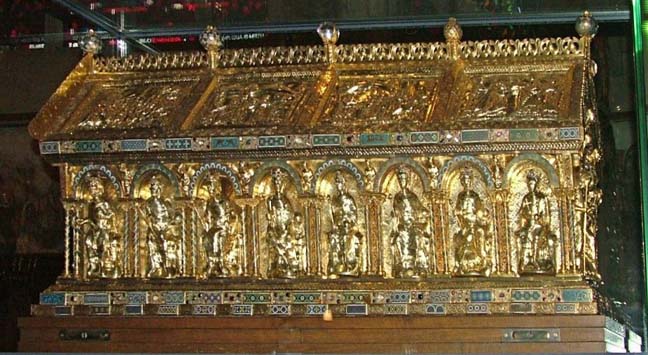
Frederick II's Gold and Silver Casket for Charlemagne
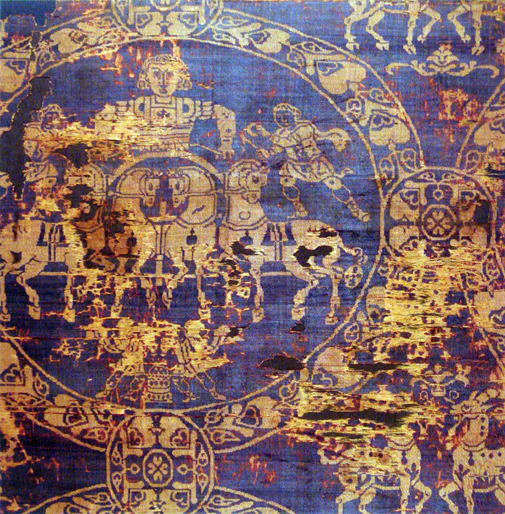
Shroud of Charlemagne manufactured in Constantinople: 814
He was succeeded by his surviving son, Louis, who had been crowned the previous year. His empire lasted only another generation in its entirety; its division, according to custom, between Louis's own sons after their father's death laid the
foundation for the modern states of Germany and France.

Charlemagne
As an administrator, Charlemagne stands out for his many reforms: monetary,
governmental, military, cultural, and ecclesiastical. He is the main protagonist of the
"Carolingian Renaissance."
Military
It has long been held that the dominance of Charlemagne's military was based on a "cavalry revolution" led by Charles Martel in 730's. However, the stirrup, which made the "shock cavalry" lance charge possible, was not introduced to the Frankish kingdom until the late eighth century. Instead, Charlemagne's success rested primarily on novel siege technologies and excellent logistics. However, large numbers of horses were used by the Frankish military during the age of Charlemagne. This was because horses provided a quick, long-distance method of transporting troops, which was critical to building and maintaining such a large empire.
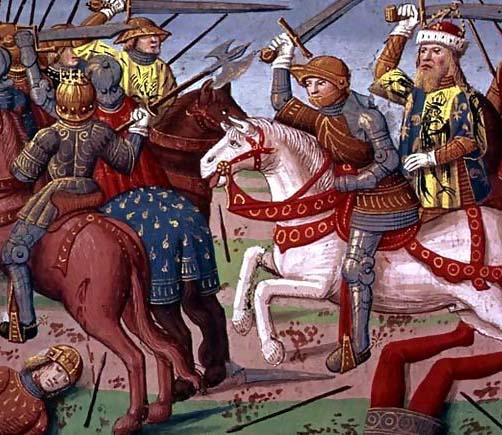
Emperor Charlemagne and his Army Fighting the Saracens in Spain,
778 - from 'The Story of Ogier'
Economic and Monetary Reforms
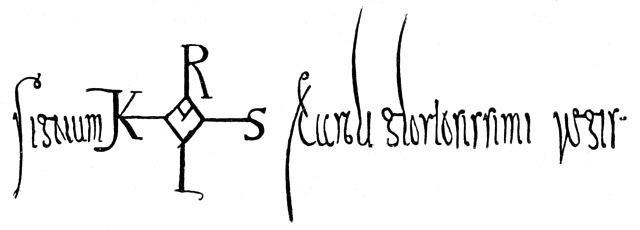
Monogram of Charlemagne, from the subscription of a royal diploma:
"Signum (monogram: KAROLVS) Karoli gloriosissimi regis"
Charlemagne had an important role in determining the immediate economic future of Europe. Pursuing his father's reforms, Charlemagne abolished the monetary system based on the gold sou, and he and the Anglo-Saxon King Offa of Mercia took up the system set in place by Pippin. There were strong pragmatic reasons for this abandonment of a gold standard, notably a shortage of gold itself, which was a direct consequence of the conclusion of peace with Byzantium, which resulted in the ceding of Venice and Sicily and the loss of their trade routes to Africa and to the East. This standardization also had the effect of economically harmonizing and unifying the complex array of currencies which had been in use at the commencement of his reign, thus simplifying trade and commerce.
He established a new standard, the livre carolinienne (from the Latin libra, the modern pound), which was based upon a pound of silver - a unit of both money and weight - which was worth 20 sous (from the Latin solidus which was primarily an accounting device and never actually minted, the modern shilling) or 240 deniers (from the Latin denarius, the modern penny). During this period, the livre and the sou were counting units; only the denier was a coin of the realm.
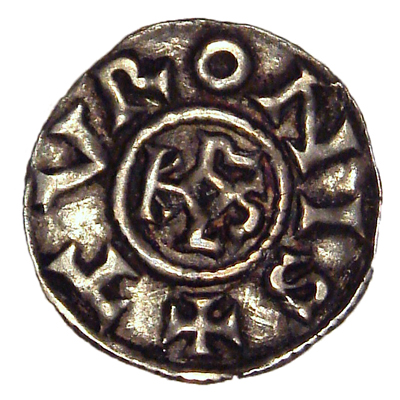
Charlemagne-denier-Tours: 793–812
Charlemagne instituted principles for accounting practice by means of the Capitulare de villis of 802, which laid down strict rules for the way in which incomes and expenses were to be recorded.
The lending of money for interest was prohibited and then strengthened in 814, when Charlemagne introduced the Capitulary for the Jews, a draconian prohibition on Jews engaging in money-lending.
In addition to this macro-oriented reform of the economy of his empire, Charlemagne also performed a significant number of microeconomic reforms, such as direct control of prices and levies on certain goods and commodities.
Charlemagne applied the system to much of the European continent, and Offa's standard was voluntarily adopted by much of England. After Charlemagne's death, continental coinage degraded, and most of Europe resorted to using the continued high - quality English coin until about 1100.
Education Reforms
A part of Charlemagne's success as warrior and administrator can be traced to his admiration for learning. His reign and the era it ushered in are often referred to as the Carolingian Renaissance because of the flowering of scholarship, literature, art, and architecture which characterize it. Charlemagne, brought into contact with the culture and learning of other countries (especially Visigoth Spain, Anglo-Saxon England, and Lombard Italy) due to his vast conquests, greatly increased the provision of monastic schools and scriptoria (centers for book-copying) in Francia. Most of the presently surviving works of classical Latin were copied and preserved by Carolingian scholars. Indeed, the earliest manuscripts available for many ancient texts are Carolingian. It is almost certain that a text which survived to the Carolingian age survives still. The pan-European nature of Charlemagne's influence is indicated by the origins of many of the men who worked for him: Alcuin, an Anglo-Saxon from York; Theodulf, a Visigoth, probably from Septimania; Paul the Deacon, Lombard; Peter of Pisa and Paulinus of Aquileia, Italians; and Angilbert, Angilram, Einhard, and Waldo of Reichenau, Franks.
Charlemagne took a serious interest in scholarship, promoting the liberal arts at the court, ordering that his children and grandchildren be well-educated, and even studying himself (in a time when even leaders who promoted education did not take time to learn themselves) under the tutelage of Paul the Deacon, from whom he learned grammar; Alcuin, with whom he studied rhetoric, dialectic (logic), and astronomy (he was particularly interested in the movements of the stars); and Einhard, who assisted him in his studies of arithmetic. His great scholarly failure, as Einhard relates, was his inability to write: when in his old age he began attempts to learn - practicing the formation of letters in his bed during his free time on books and wax tablets he hid under his pillow - "his effort came too late in life and achieved little success", and his ability to read - which Einhard is silent about, and which no contemporary source supports - has also been called into question.
In 800, Charlemagne enlarged the hostel at the Muristan in Jerusalem and added a library to it. He certainly had not been personally in Jerusalem.
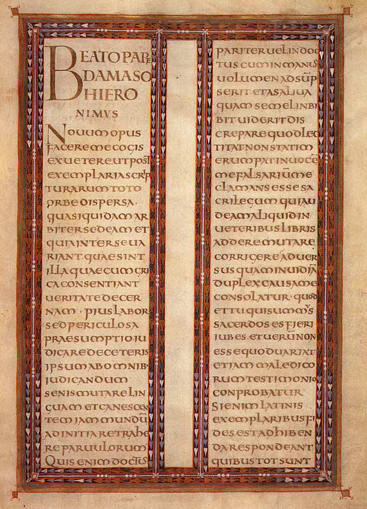
Page from the Lorsch Gospels of Charlemagne's reign
Writing Reforms
During Charles' reign, the Roman half uncial script and its cursive version, which had given rise to various continental minuscule scripts, were combined with features from the insular scripts that were being used in Irish and English monasteries. Carolingian minuscule was created partly under the patronage of Charlemagne. Alcuin of York, who ran the palace school and scriptorium at Aachen, was probably a chief influence in this. The revolutionary character of the Carolingian reform, however, can be over-emphasized; efforts at taming the crabbed Merovingian and Germanic hands had been underway before Alcuin arrived at Aachen. The new minuscule was disseminated first from Aachen and later from the influential scriptorium at Tours, where Alcuin retired as an abbot.
Political Reforms
Charlemagne engaged in many reforms of Frankish governance, but he continued also in many traditional practices, such as the division of the kingdom among sons.
Organization
The Carolingian king exercised the bannum, the right to rule and command. He had supreme jurisdiction in judicial matters, made legislation, led the army, and protected both the Church and the poor. His administration was an attempt to organize the kingdom, church, and nobility around him. However, the effort was heavily dependent upon the efficiency, loyalty, and support of his subjects.
Imperial Coronation
Historians have debated for centuries whether Charlemagne was aware of the Pope's intent to crown him Emperor prior to the coronation (Charlemagne declared that he would not have entered Saint Peter's had he known), but that debate has often obscured the more significant question of why the Pope granted the title and why Charlemagne chose to accept it once he did.
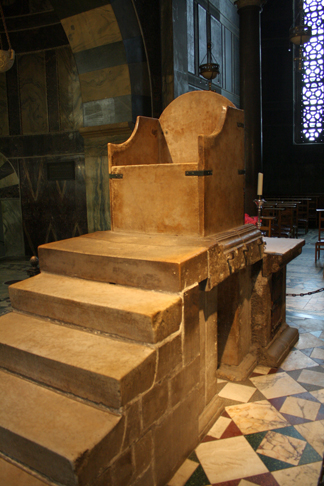
Throne of Charlemagne: 1661
Roger Collins points out "That the motivation behind the acceptance of the imperial title was a romantic and antiquarian interest in reviving the Roman empire is highly unlikely." For one thing, such romance would not have appealed either to Franks or Roman Catholics at the turn of the ninth century, both of whom viewed the Classical heritage of the Roman Empire with distrust. The Franks took pride in having "fought against and thrown from their shoulders the heavy yoke of the Romans" and "from the knowledge gained in baptism, clothed in gold and precious stones the bodies of the holy martyrs whom the Romans had killed by fire, by the sword and by wild animals", as Pippin III described it in a law of 763 or 764. Furthermore, the new title - carrying with it the risk that the new emperor would "make drastic changes to the traditional styles and procedures of government" or "concentrate his attentions on Italy or on Mediterranean concerns more generally" - risked alienating the Frankish leadership.
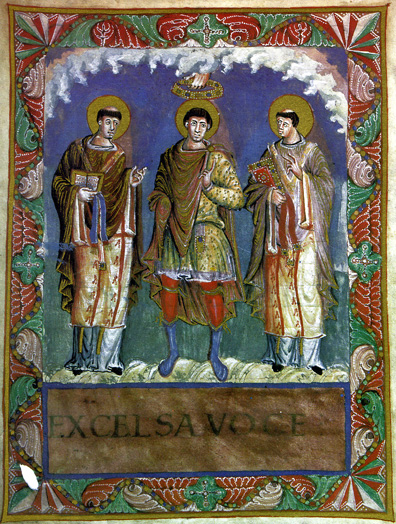
Coronation of an Idealized King
For both the Pope and Charlemagne, the Roman Empire remained a significant power in European politics at this time, and continued to hold a substantial portion of Italy, with borders not very far south of the city of Rome itself - this is the empire historiography has labeled the Byzantine Empire, for its capital was Constantinople (Ancient Byzantium) and its people and rulers were Greek; it was a thoroughly Hellenic state. Indeed, Charlemagne was usurping the prerogatives of the Roman Emperor in Constantinople simply by sitting in judgment over the Pope in the first place:
By whom, however, could he (the Pope) be tried? Who, in other words, was qualified to pass
judgment on the Vicar of Christ? In normal circumstances the only conceivable answer to that
question would have been the Emperor at Constantinople; but the imperial throne was at this
moment occupied by Irene. That the Empress was notorious for having blinded and murdered her
own son was, in the minds of both Leo and Charles, almost immaterial: it was enough that she
was a woman. The female sex was known to be incapable of governing, and by the old Salic
tradition was debarred from doing so. As far as Western Europe was concerned, the Throne of
the Emperors was vacant: Irene's claim to it was merely an additional proof, if any were needed,
of the degradation into which the so-called Roman Empire had fallen.
~ John Julius Norwich, Byzantium: The Early Centuries
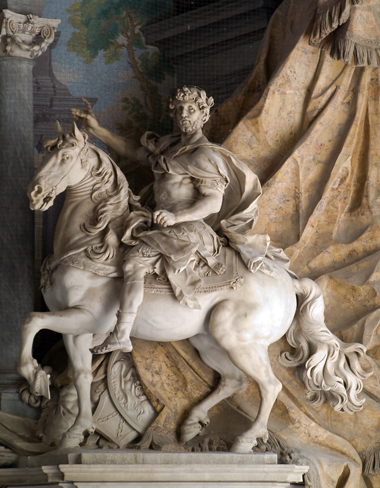
Statue of Charlemagne
by Agostino Cornacchini
Divisio Regnorum
In 806, Charlemagne first made provision for the traditional division of the empire on his death. For Charles the Younger he designated Austrasia and Neustria, Saxony, Burgundy, and Thuringia. To Pippin he gave Italy, Bavaria, and Swabia. Louis received Aquitaine, the Spanish March, and Provence. There was no mention of the imperial title however, which has led to the suggestion that, at that particular time, Charlemagne regarded the title as an honorary achievement which held no hereditary significance.
This division might have worked, but it was never to be tested. Pippin died in 810 and Charles in 811. Charlemagne then reconsidered the matter, and in 813, crowned his youngest son, Louis, co-emperor and co-King of the Franks, granting him a half-share of the empire and the rest upon Charlemagne's own death. The only part of the Empire which Louis was not promised was Italy, which Charlemagne specifically bestowed upon Pippin's illegitimate son Bernard.
Quoted From: Charlemagne - Wikipedia
Additional Sources:
Return to Persona Historiae
Return to Pagina Artis
Return to Bruce and Bobbie's Main Page.